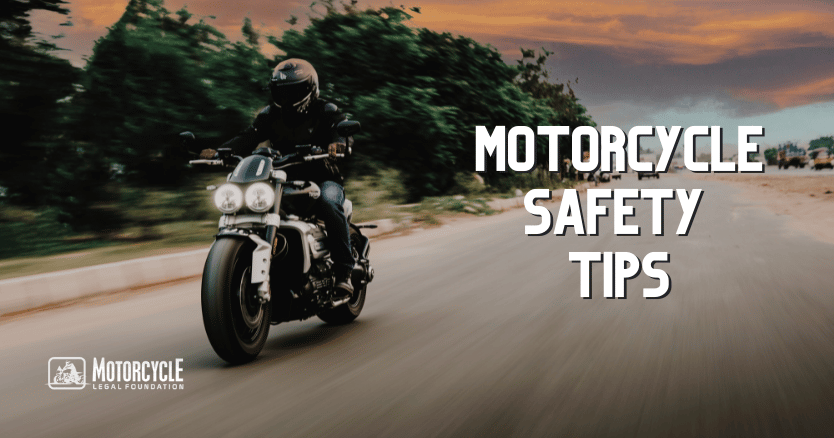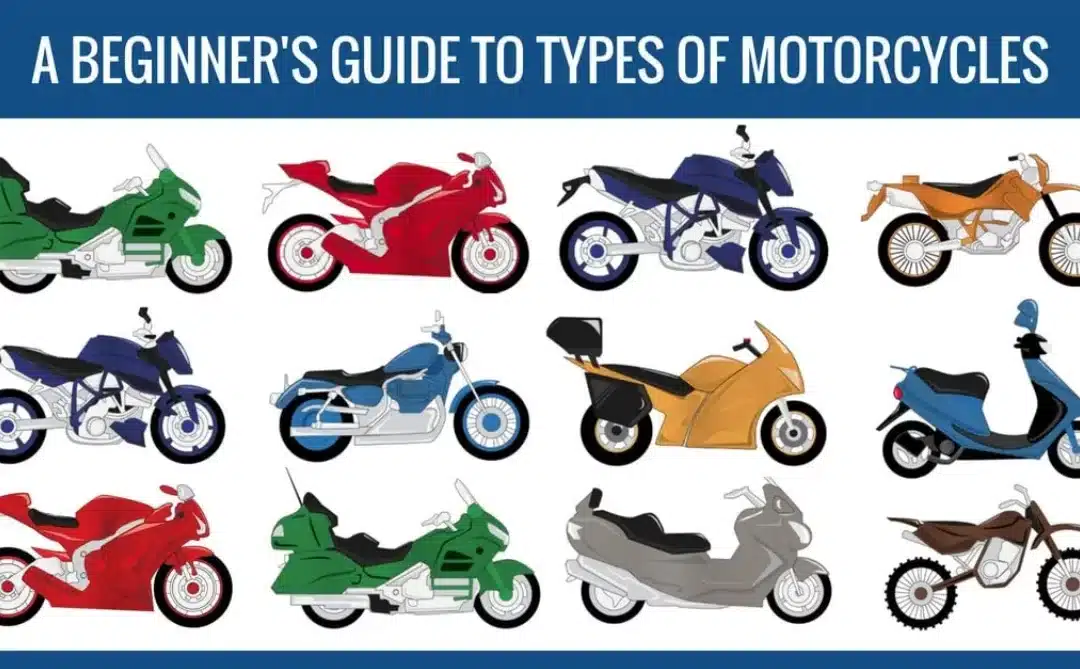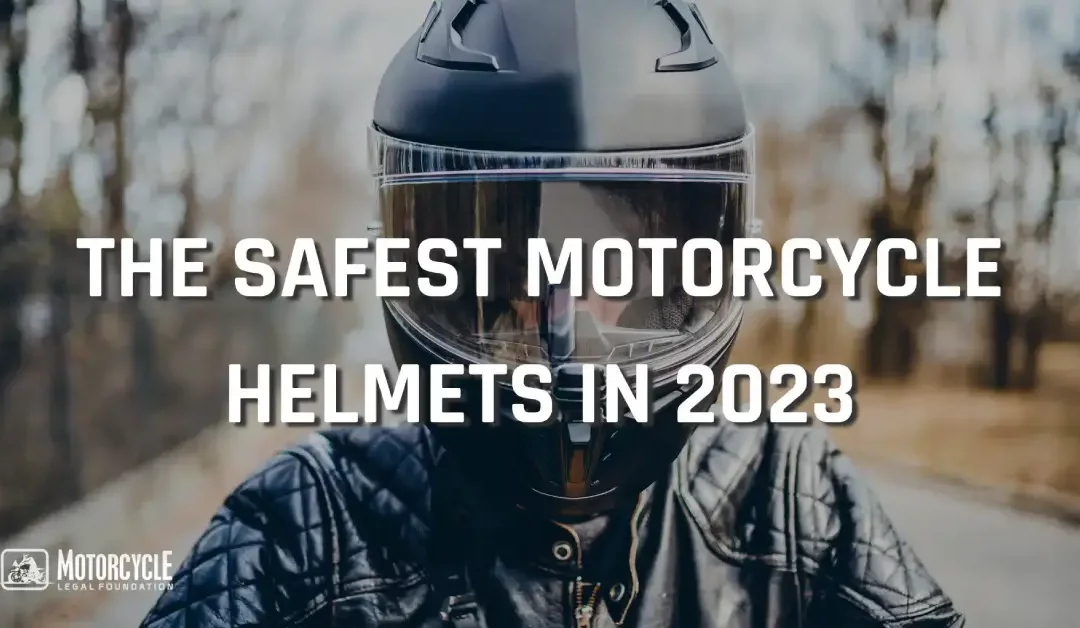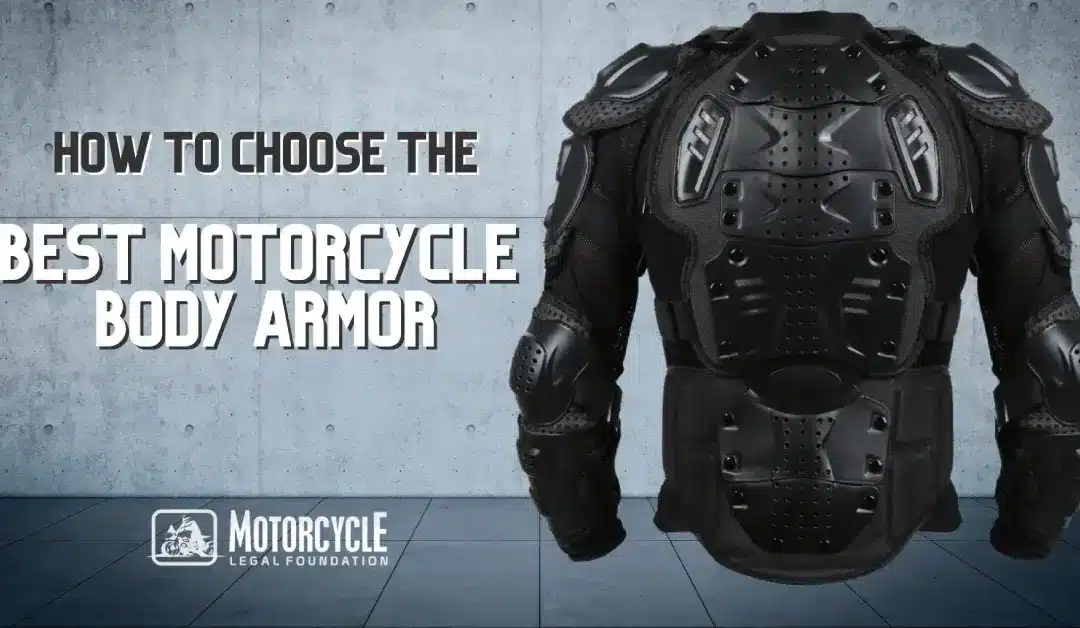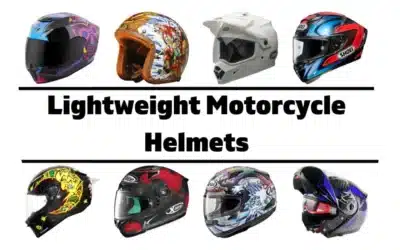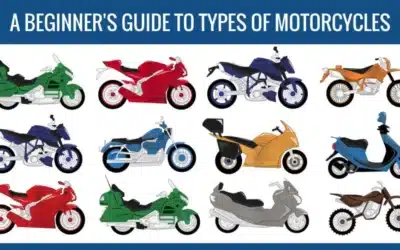Investing in a Motorcycle Within Your Riding Ability
ATGATT
Motorcycle Gear
Motorcycle Education
Motorcycle Riding Tips
Conclusion
So you finally have the itch to try riding a motorcycle. You’ve seen racing on TV, you’ve seen a lot of motorcycle riders in your area, and you want to get in on the fun. Everyone is always smiling when they are riding. How hard can it be?
While it all seems like innocent fun, the truth is motorcycling can be very dangerous. In 2016, 5,286 motorcyclists were killed while riding. Within the last seven years, there has been an average of 4,200 motorcyclist fatalities yearly. The causes range from drinking alcohol before riding, not wearing a helmet, and unfortunate interactions with other motorists.
You can’t avoid all dangerous situations, but you can take steps to have a safe motorcycle experience. The key is preparing yourself before you ride, knowing what to look for during a ride, and knowing what to do when you recognize danger. It’s crucial to prioritize your safety and those around you. We created the ultimate safety guide with an extensive list of motorcycle safety tips to help you minimize dangerous motorcycle situations and enjoy your time on the road.
Buy a Motorcycle Within Your Riding Ability
When you first start riding, a big decision is identifying what kind of motorcycle fits your needs and experience level. A significant first step is to identify your reason for riding. If you plan to commute to work, ride on the weekends, or race on a closed track, having a big touring motorcycle may not be your best bet.
It might help to initially purchase a used motorcycle before deciding if you enjoy motorcycling as much as you thought. Some riders go full throttle on buying a new motorcycle with all the bells and whistles, later realizing that they don’t ride the motorcycle nearly as much as they thought they would.
Before you invest in a new or used motorcycle, you’ll want to decide on the type of motorcycle you want. There are many options, and a beginner motorcycle will be where you want to start. Once you’ve identified the type of motorcycle fit for your lifestyle, you’ll want to size yourself and find a motorcycle for your height and size. Your height and body size will determine your safest motorcycle option as a new rider getting accustomed to being on two motorized wheels. With your approximate size established, the choices narrow down quickly. Within each type available, some will be a better option for a new rider. Look at the safest motorcycles available on the market and learn what makes them safe.
ATGATT
ATGATT stands for All The Gear, All The Time. As a new rider, ATGATT should be more than a catchy acronym – it needs to be your new mindset. Where motorcycle safety gear is arguably an option to some, as a new rider, it should be a requirement. You’re still new to riding and you need to stay safe as you establish your riding skills. There are a lot of options available for motorcycle-specific safety equipment, and choosing the best gear for you isn’t always an easy task. Some safety staples include:
Use the Proper Motorcycle Gear
Helmet
The helmet is the most critical safety equipment you must wear while riding a motorcycle. According to the NHTSA, In 2016, 2,089 motorcyclists lost their lives by not wearing a helmet. In addition, almost all states require a helmet while riding.
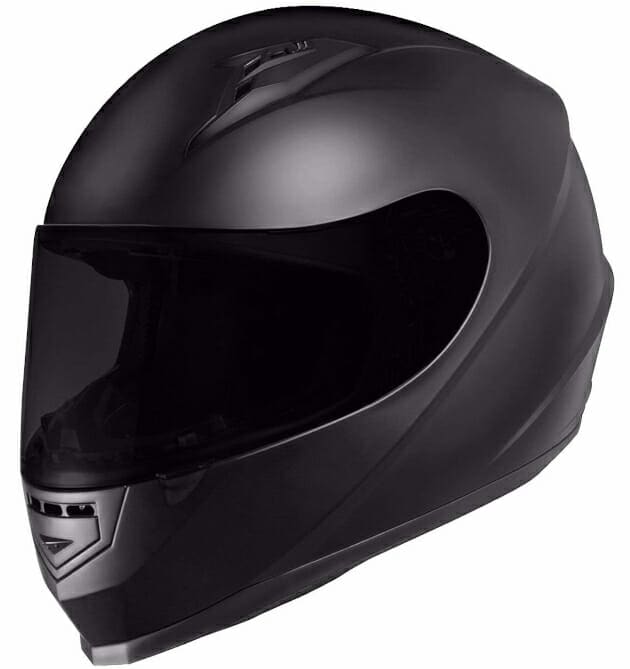
Be sure you wear a DOT-certified helmet or comply with the current European safety standard 22.05. The DOT-certified helmet should have the manufacturer name, model, text FMVSS218, and DOT on the helmet.
When choosing a helmet, you’ll need to decide if you like a full-face, ¾ coverage, or ½ coverage helmet the best. The full-face will offer the most protection for your face and head, while the ½ helmet will provide the least of the three options. Any options should fit snugly on your head without being uncomfortably tight or loose enough to twist back and forth without moving your cheeks. Here are our recommendations on the safest motorcycle helmets.
Jacket
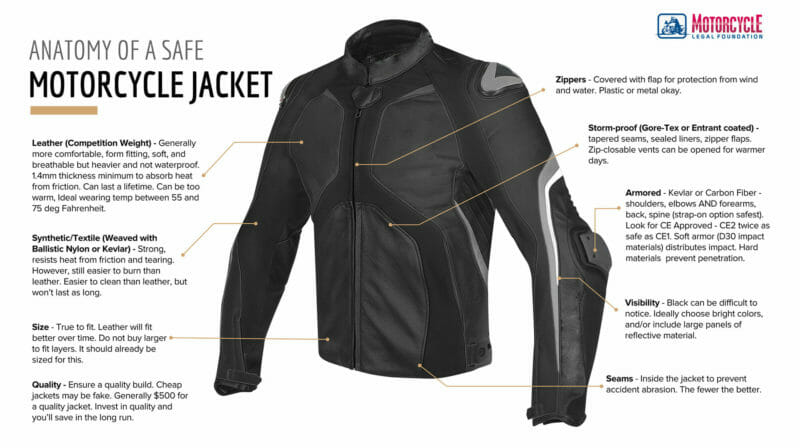
A good motorcycle jacket can offer safety far beyond regular clothing and provide superior protection from the environment in the event of a fall. Consider it the second most important gear to wear on the road.
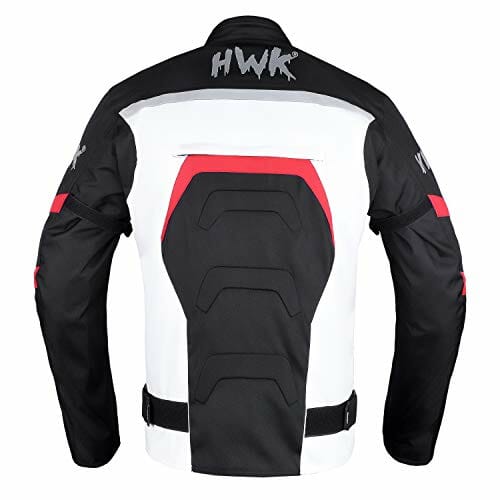
When looking for your first motorcycle jacket, shop based on the function and fit before choosing a design. It should fit snugly like a helmet but not be uncomfortably tight or loose. Look for a quality material that will be durable and function in the environment you plan to ride in.
Look for a leather jacket or suit if you plan to ride only on a closed racetrack. For casual off-road riding, a textile material may be the better option. There isn’t a proper clothing standard to ensure quality, but we recommend buying the thickest material for abrasion resistance. Choose jackets that offer built-in protection, and look for those with enough pockets to store everything you’ll need (license, registration, etc.). For additional info, check out our tips on choosing the safest motorcycle jacket.
Gloves
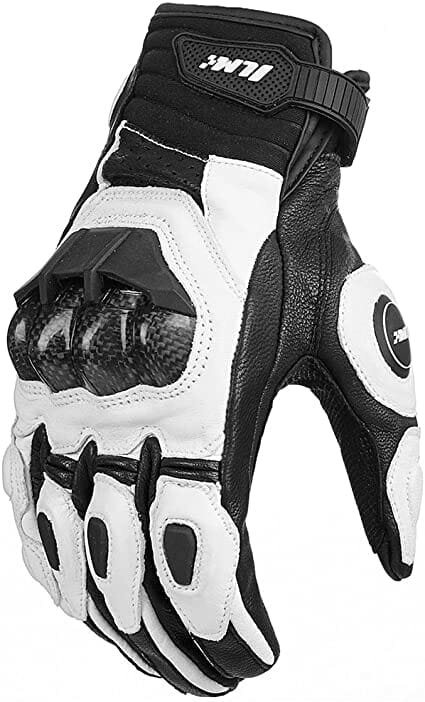
Gloves are crucial to avoid pebbles or giant bugs hitting your knuckles. Additionally, gloves offer your hands added comfort and safety while riding. They provide sun and windburn protection, shield the hands from flying objects on the road, and added material provides additional grip for safer riding.
There are different materials for gloves, from leather to textile and waterproof to water-resistant. Leather is an excellent option for abrasion resistance and comfort but doesn’t resist water penetration. Textiles are typically less resistant to abrasion but offer excellent weather protection.
Gloves should fit snugly, similarly to a jacket and helmet. They shouldn’t be too tight that movement is constricted or blood circulation is cut off. They should offer finger maneuverability that allows you to operate the controls freely. Gloves usually cinch at the wrist through a strap or elastic material to keep them secure while riding.
Boots
While some would argue that a good hiking boot is good enough to ride in, the laces on the boots can become a problem with entanglement. On the other hand, a proper motorcycle boot will offer protection, comfort, and good tread between you and the road surface.
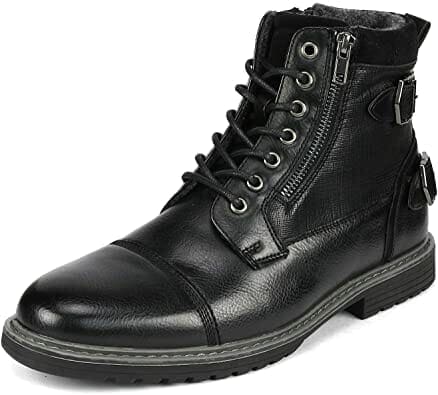
Boots are offered in a leather or textile option, and where and how you ride will dictate what will work best for you. Textile materials usually provide good weather protection. If you’re not planning to ride in the rain or light snow, leather material may be a great option. You can coat them in a waterproof layer after purchase, which can help keep your feet dry if you run into a pop-up storm.
Boots should fit tight but comfortably on your feet. They should be over the ankle in height as the ankle generally takes the abuse in motorcycling. Most motorcycle boots have extra protection around the ankle to prevent abrasion in the event of an accident, whereas regular boots typically do not. Motorcycle boots should have a sound closing system to hide any laces, such as a hook-and-loop strip to keep everything tucked away, and they should have an oil-resistant sole to give you great traction when you come to a stop at an intersection.
Pants
Motorcycle riding pants offer comfort and protection for your lower body. They can fit over a standard set of pants or shorts if you’re commuting from one destination to the next. However, shorts offer no absolute protection for your legs while riding and are a poor choice under any circumstances.
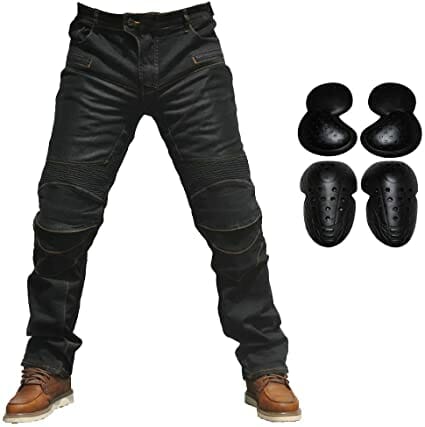
Jeans are acceptable but don’t offer much abrasion resistance if you have an accident. Some of the leather pants may fit better without a second set of pants underneath, so try on the set to see what will work best and be comfortable. You want them to be tight enough and avoid causing an issue with foot controls or riding comfort while on the road.
Your riding style may help dictate the best material to ride in. Leather offers excellent protection but can get hot in the warmer months. It usually has a built-in cooling feature for airflow while riding; some will come with extra padding in the knees, hips, and thigh areas. Suppose you don’t need the extra protection of leather. In that case, Kevlar and denim combinations offer comfort without the extra weight of leather and padding. If you need a little extra weather protection, there are textile offerings that have a good mix of waterproofing, abrasion resistance, and comfort for all riding weather.
Riding Suit
Most riders probably think of full racing leathers when one-piece suits are mentioned. Beyond the top of the line leather and Kevlar suits, you can often find a nice textile suit that offers all-weather protection, comfort, and abrasion resistance. Some offer additional padding in the high-impact areas like elbows, hips, and knees too. Your one-piece suit may be designed to fit over a regular set of clothes, or just be worn as the exterior layer. Be sure not to buy them too tight as it can be restrictive, nor too loose that it can cause an issue while riding and when using the foot controls. Be sure to try them on and sit on a comparable motorcycle to yours to ensure they fit well before purchasing.
Accessories
When you hear riding accessories, you may think that means adding some chrome, a new seat, or something to your motorcycle. When riding, there are some good options to consider that will make the ride more comfortable and safer:
- Ear Protection – Consider riding with a set of earplugs that will block the sound of the wind rushing past your helmet and ears. Hearing the white noise tires out your hearing and reduces your thought process. One great benefit of wearing earplugs is that they will reduce your fatigue at the end of a ride. It won’t diminish your ability to hear the surrounding traffic while riding, and it will tone down the white noise of the wind.
- Eye Protection – Eye protection can come in various forms, from riding glasses that mimic sunglasses to tinted visors on your helmet. If you’re only wearing a ½ helmet, you’ll want a set of riding glasses or goggles to protect your eyes. Riding-specific eyewear will be shatter-resistant and may come in various tinting options to help with bright daylight or low light conditions. It should wrap around your face and deflect wind and debris from irritating your eyes while riding. If you wear a ¾ or full-face helmet, you may be able to forego the second set of eye protection, as the visor will protect your eyes from debris and sunlight. You can always add a tinted set of riding glasses with a clear visor, which gives you options for all sunlight levels without the need to change to a tinted visor when it gets dark. Take a Motorcycle Course When you first start riding, it can be overwhelming to master the controls and flow with the dangers of traffic. Rather than try to learn the basics on the fly, we suggest you take a riding course to help perfect your riding skills before you hit the open road.
Need Motorcycle Insurance?
Enjoy your ride while feeling safe with the best insurance coverage.
Safe Motorcycle Riding Tips
Your body position is going to constantly change while you’re riding. Rarely do you just sit on a motorcycle without changing how much you lean to corner or adjusting your arms for comfort and use of the vehicle. The basics of riding posture are that you want your torso in line with your hips at all times. If your waist and hips are centered on the motorcycle seat, your torso should also be centered. If you move to the right to lean the motorcycle slightly, your torso should stay centered above your hips and also lean. Your arms should stay slightly bent in a comfortable position with your elbows bent and near your body. Over-extending your arms away from your body causes fatigue over time so do your best to ride with them comfortably close to your body. Your knees should hug the fuel tank and your feet should stay on the footpegs near the controls, ready to take any immediate action if necessary. Being in a stable and comfortable position on your motorcycle can also make it easier to perform any motorcycle hand signals that you may need to use on the road.
Leaning
Leaning a motorcycle while staying balanced is a complicated exercise. It requires a body position to the inside of the motorcycle seat, looking through the corner where you want to go, and a counter-steer to start the initial lean. Leaning requires you to have a certain amount of corner speed to find a balance on the motorcycle. Too much of one, or not enough of the other, may mean you run through a corner or ride at the edge of the pavement where you didn’t plan to be.
Braking and Turning
As a new rider, it is best to brake before you turn and keep each action separated. Braking before entering a turn compresses the front suspension, and you want the force pushing down on the front tire to be complete before you try to use the traction for cornering. By completing all braking before entering a turn, or entering a u-turn, you allow the motorcycle suspension to settle back to a neutral position. It is also recommended to use both front and rear brakes in a straight line as you approach the turn. That gives you maximum braking potential so that you can complete the braking faster.
Once you have counter-steered the handlebars and leaned the motorcycle into the corner, you can then slightly roll on the throttle which will help balance the motorcycle suspension. A little throttle is all that is needed for a balance but remember that more speed requires more lean to stay on the same path through a corner. Cornering speed and leaning are symbiotic and they need each other to maintain balance in a corner. As you approach the exit of the corner, you can start to slowly roll on the throttle and increase your speed to the exit of the corner and into the next straightaway.
Shifting
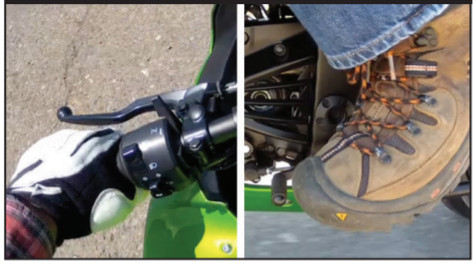
The primary function of using the clutch on your motorcycle is to change transmission gears to match the engine speed with the road speed. Upshifting the transmission using the clutch is typically pretty easy. You roll on the throttle until you find the speed that the engine needs a higher gear. You roll off the throttle, pull in the clutch lever, use your left foot to click the lever into the next higher gear, and then let the clutch out while rolling on the throttle. It will be a little awkward initially until you master the sequence over and over.
Downshifting is harder than upshifting because you will be going down where the engine will want to speed up due to the lower gear. The sequence for shifting will be similar using the throttle and clutch level, but instead of up with your foot, you’ll be pressing down. One dramatic difference will be the speed at which you release the clutch lever back out after shifting. It needs to be much slower to allow the engine to catch up with the road speed.
Counter-Steering
There are two different techniques to steering a motorcycle, and the difference occurs around 12 miles per hour when riding. Below that speed, you turn the motorcycle handlebars in the direction you want the motorcycle to go. Above 12 miles per hour, you do the opposite. Turning in the opposite direction is called counter-steering. Think of it like this: you don’t turn the handlebars, but rather you push the handlebar on the side of the motorcycle that you want to lean and turn to. If you want to go left, you push the left handlebar. The same for turning and leaning right. The reason this is required is because of the gyroscopic effect of the front wheel and forks. I know, that’s a physics discussion and we’re not going to go into it too deep. Just remember push left to go left or push right to go right. Keep it simple.
Where to Look While Riding
One of the easiest things about motorcycling is that you look where you want to go. Keep your head up looking out at the horizon. You can slightly turn your head if you want to turn, and don’t just use your eyes to look where you want to go. You are going to constantly be scanning the horizon for obstacles as you ride, and you can make adjustments while riding to avoid them as needed. One thing to keep in mind in a turn is that you want to continually look where you want to go, and that is looking through the turn and for the exit to the next straightaway. Don’t become target fixed on one object. You will tend to ride directly to it. Instead look through a turn, a corner, and exactly ride where you want to go.
Riding in Proximity to Other Vehicles
Riding in proximity to other vehicles – You are going to encounter traffic somewhere along your journey with other motorcycles, vehicles, and/or big semi-trucks. Riding next to a car is not recommended, especially if you’re in a blind spot. Try to avoid riding directly next to another vehicle. Stay to the front or rear of them in case either needs to swerve to miss debris in the road or to prevent an accident with another vehicle.
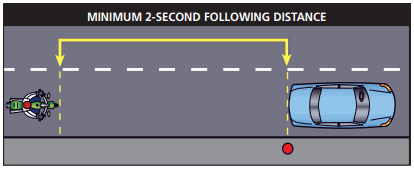
If you’re following another vehicle, give it a two-second following distance. It gives you the reaction time required to adjust your position within the lane or stop if needed. Don’t allow another vehicle to crowd you on the road. Don’t speed up hoping a vehicle behind you will give you more riding space. It will actually do the opposite of what you intended and they will speed up with you. Find a way to allow them to pass, whether that’s moving to a lane further to the right, or pulling off and letting them go by.
Escape Paths
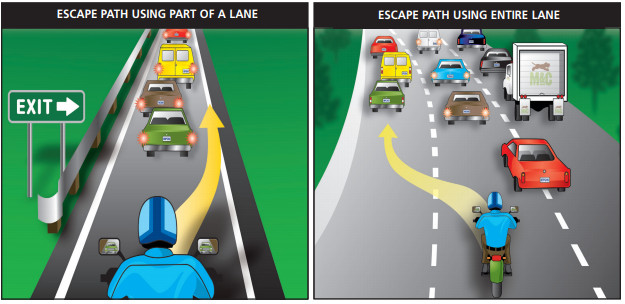
As you ride, you may find that something enters your path of travel and you need somewhere to go immediately. This is considered an escape path. You need to continually be thinking of where you would go if something enters your path and you need to maneuver around it. Can you go left quickly? Go you maneuver right? Can you do both? Keep your options open as you ride and be prepared to change course if needed. Watch for guard rails on your right that may put you in danger of being pinched between a vehicle and the barrier. Avoid debris as needed, whether that’s a quick swerve around it and correct back into the lane or stay situated.
Intersections
Intersections are where most accidents happen between a motorcyclist and another vehicle. It usually is a case of the motorcyclist being unseen and the vehicle turning in front of it, causing an accident. As you approach an intersection on your motorcycle, you need to slow down slightly even if you have the right away. Cover your controls in case you need to change directions through an escape path, or need to stop altogether. You should always assume that you aren’t seen and be ready to react to avoid a collision.
Riding Defensively
Riding defensively on a motorcycle is a little bit of a game where everyone is out to get you. You need to continually adjust your position within the lane to offer an escape path and keep distance between you and other riders and vehicles. Constantly scan for road debris to maneuver around, and be prepared to take evasive action when the time comes.
Riding According to Your Skills and Ability
Riding a motorcycle is exciting, but don’t allow yourself to go above your ability and current skill level. It’s pretty common to find a good group of riders to join, but sometimes they are far more experienced than a new rider. You don’t have to ride at their level, nor at their speed. They want you to arrive at the checkpoint and final destination safe and sound. Get there at your own speed, even if that means you let them ride ahead while you stay comfortable in your current riding zone.
Maintaining Safe Speed
Finding a safe speed to ride at will take an evaluation of the environment and how quickly you can react. If you’re riding alone on a stretch of the open road, you can probably ride a higher speed. You should have fewer obstacles to worry about, and you have more ability to maneuver and stop if the situation calls for it. If you’re in heavy traffic, you’re probably not able to ride at a high rate of speed. Traffic with other motorists will most likely cause you to slow down and be ready to avoid other vehicles with defensive riding.
Cognizance of Other Vehicles
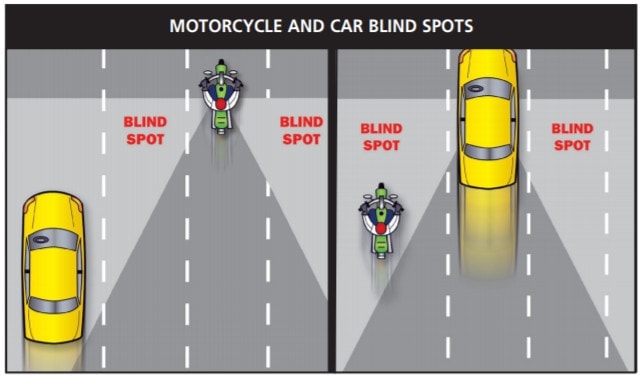
There are 32 other vehicles on the road for every registered motorcycle that is being ridden. Most, if not all, of those 32 other vehicles are larger and heavier than you and your motorcycle. That means you need to respect their space and stay defensive at all times. You’re smaller than everything on the road, have the best maneuverability, and are the hardest thing to see too. Stay out of blind spots, ride safe, and arrive alive.
Road Hazards
It would be great if you always had perfect pavement without debris in your path of travel. But the truth is, you most often won’t find that. If you’re riding with your head up and eyes out to the horizon where you want to go, you’re most likely able to spot road hazards like potholes, bumps, dips, and road debris. One way to recognize objects in your path is to watch vehicles ahead of you. Do they swerve to avoid something, do they change position in the lane, etc.? That can indicate a hazard on the road. Keep in mind that cars and trucks can travel over something that you may not be able to. You may need to swerve around something that they drove over.
Visibility
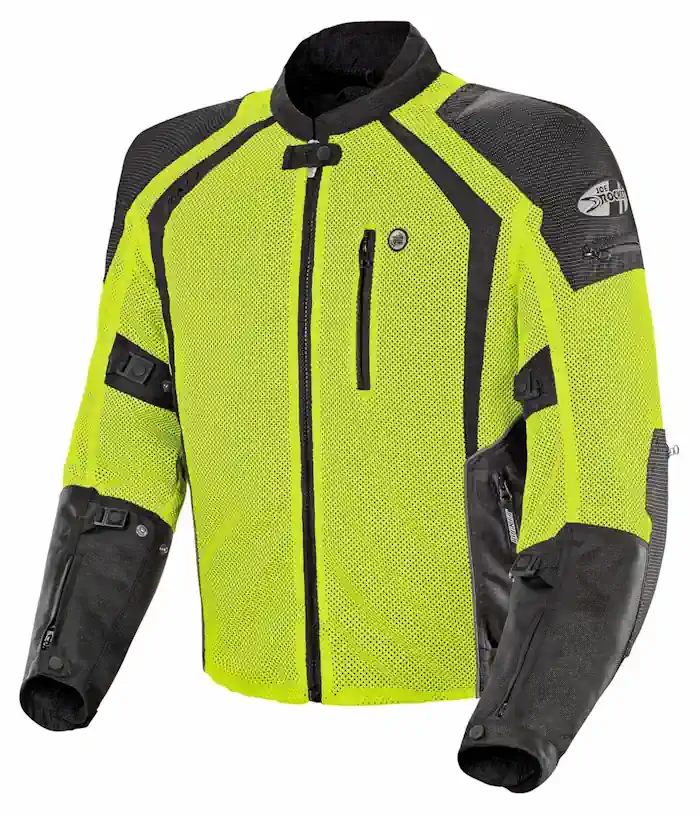
You are probably at some point going to ride at low daylight levels or in the nighttime unless you have a steadfast rule of only riding when the sun is high in the sky. There are some differences in strategy for each because of the difference in light levels and your ability to be seen by other motorists. The key to riding safe is your visibility, demonstrated with a headlight and high-visibility gear. When you look for new motorcycle gear, consider those with retro-reflective patches that direct light back to the source giving them a glowing effect.
Weather Conditions
Inclement weather happens, and sometimes you get caught riding in less than ideal weather. Water obviously makes the road surface wet, but when mixed with oil it can become very hazardous. It’s best to avoid riding in inclement weather, if possible. It’s usually not your ability to ride that makes it dangerous. It’s the other motorists and a slick riding surface that make it tough. For more information on riding in weather conditions, visit:
- How to Ride a Motorcycle in the Rain(w/ Infographic)
- How to Safely Ride a Motorcycle in Windy Conditions
- Everything You Need to Know About Motorcycle Night Riding
Anti-Lock Brakes (ABS)
If you know about ABS, or Anti-Lock Braking systems, you know they are an advantage for stopping sooner with more control potentially. As a new rider, ABS is a definite plus on your motorcycle. Many of the new motorcycle models offered have an ABS option, and if you are looking at a motorcycle with the option available, we recommend upgrading.
Traffic Laws
When riding close to home, it’s easy to know what the laws are. You probably reviewed them when you took an MSF rider class or when getting your license at the local DMV office. When you start to venture outside of the familiar territory, you may cross state lines that have different laws. Review the state’s motorcycle laws to ensure you are abiding by them. For information on your state’s motorcycle traffic laws visit:
- State-by-State Guide to Motorcycle Laws (w/ Maps)
- Motorcycle Lane Splitting: Legality by State + Guidelines
Riding Impaired
When you think of impairment, most will immediately think of alcohol being involved. Approximately 25% of all motorcyclists killed while riding had some form of alcohol impairment. In addition to alcohol, tiredness is just as troubling. Motorcycling is hard enough when you’re 100%. Don’t ride impaired. Save the alcohol for another time when you’re not going to operate a motor vehicle and when you’ve also had a good night’s rest. Keep your spirits up and be in a good mood. Impairment from your best condition can come in many forms. Learn to recognize what deters you from riding at your best.
Keep a Tool Pouch and First-aid Kit on your Motorcycle
Storage is generally limited on a motorcycle, but having a small tool pouch and a basic first aid kit can really save you on a ride. Given how little space there is, the tools should be kept to small wrenches in the most common sizes your motorcycle uses. That may be 3/8” – 5/8” on an American motorcycle or 8mm – 14mm on an imported motorcycle. You can often find a set of small combination wrenches online and then add a couple of screwdrivers to the set for a quick emergency tool kit. Add a basic first aid kit to the bundle and you’ll be all set.
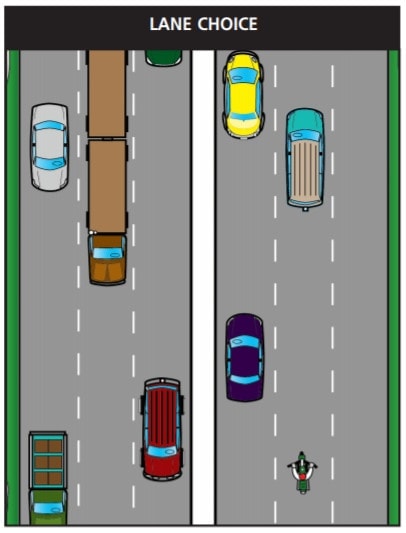
Ride in the Safest Lane
If you ask three people which lane is the safest, you may get three different answers. The truth is, there isn’t one lane that is always best for every situation. The safest lane may change depending on what you’re riding around and through. Being close to the off-ramp may be a good option, and sometimes that escape path could be to your left or your right. The safest lane is the one that gives you great visibility and allows you to clearly see the road ahead.
Takeaways
Motorcycling may be a hobby to some and a lifestyle to others. However, we all start in the same place. We start by learning to ride a motorcycle through self-navigation, a guided class, and/or private instruction. Motorcycling gear has many options to choose from, but having it should be high on your list of things you need to stay safe on a motorcycle ride. Beyond the physical tools, you need to be in a good mental state to stay safe while on the open road. Stay safe by riding when you’re 100% and avoid any impairment as best as possible. Motorcycling is difficult, but continually growing your skills through education and repetition will keep you enjoying motorcycling as long as you want to stay on two wheels. Good luck and ride safely!
Have You Been Involved In A Motorcycle Accident?
Our professional legal team screens submissions and assigns cases to some of the best motorcycle lawyers in the US.

